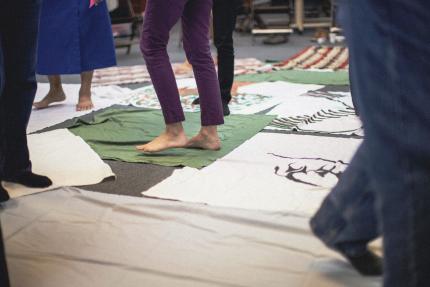Reconciliation through the Blanket Exercise

People participate in Blanket Exercise.
John Visser Photography
Elna Siebring remembers the day that her high school gave a standing ovation for a student because she was the first Indigenous female student to graduate from Cowichan Secondary School on Vancouver Island.
That day she began asking herself why this was the first Indigenous female student to graduate in the 37 years of the school’s existence. “It was a question that lived with me,” she says.
The answer to that question finally came during her first experience of the Blanket Exercise at a Diaconal Ministries board meeting in 2008.
“I was blown away. The Blanket Exercise was so powerful,” she says.
The Blanket Exercise is a participatory exercise that walks participants through the history of Canada and the United States from Indigenous peoples’ perspectives. In the words of Synod 2015, it is “a practical, powerful, experiential way to understand history in the Canadian and American contexts.”
That same year, in 2008. Prime Minister Stephen Harper had offered a full apology for Canada’s Indian Residential School system, which was meant to assimilate Indigenous children into white mainstream society.
Several of those schools were near Siebring’s hometown. She explains that she grew up around a lot of prejudices towards Indigenous people on Vancouver Island.
“The Blanket Exercise turned that all upside down,” she says, “because now I knew about residential schools and the history… And then I thought, ‘How do you heal from this?’ We need to learn our shared history.”
Seeking that healing and learning brought Siebring to Truth and Reconciliation Commission events in both Halifax and Victoria. She gathered a small group to attend those meetings.
In 2013, she had a conversation that she says would lead to a dramatic life shift. She was speaking with new friends about the Blanket Exercise at the Day of Encouragement in Ancaster, Ontario, when one of them joked that she should quit her day job so that she could lead the Exercise more often.
“And that stayed with me,” she says.
The following spring, while leading a Blanket Exercise at Dalhousie University in Halifax, Siebring recalls, “I heard the voice of God clearly in my spirit: ‘Leave your community networking job and do the Blanket Exercise.’”
“I had so much peace about it,” she says. She gave her notice at her job at All Nations Christian Reformed Church in April 2014.
The next day she received two part-time job offers that would cover her living expenses and give her the flexibility she needed to lead the Blanket Exercise.
Now she leads the Blanket Exercise with friends about four times a month in the Halifax area at universities, schools, and churches.
Siebring’s relationship with Marilyn, a Cree woman who she met at All Nations CRC, continues to shape her. They get together every couple of months.
“I remember the first time when she said the Lord’s Prayer with me in her language,” Siebring says. “It was a deep pivotal moment of trust.”
Siebring says that she has learned much from Marilyn about respect for the Creator, creation and thankfulness. “I am learning from Marilyn how to hold all of life as sacred.”
Just this month, the CRC in Canada has signed on to the United Nations Declaration on the Rights of Indigenous Peoples through the Board of Trustees, following the recommendation of the Truth and Reconciliation Commission.
Siebring sees living into the Declaration as the next step. “The Declaration outlines what justice looks like. We can’t have reconciliation without justice,” she says.
What does seeking justice with Indigenous peoples look like?
Siebring says, “What about water projects? The drinking water crisis in Indigenous communities is not insurmountable. Or education? We’re big supporters of Christian schools, but how can we empower them to have their own schools, too? There is a huge funding discrepancy between provincial schools and federally funded reserve schools.”
On both water rights and education, she insists that the CRC has expertise to offer to Indigenous peoples, “We have people who can walk alongside them.”
Editor’s note: You can listen to the United Nations Declaration on the Rights of Indigenous Peoples at this link: https://vimeo.com/51598291.

